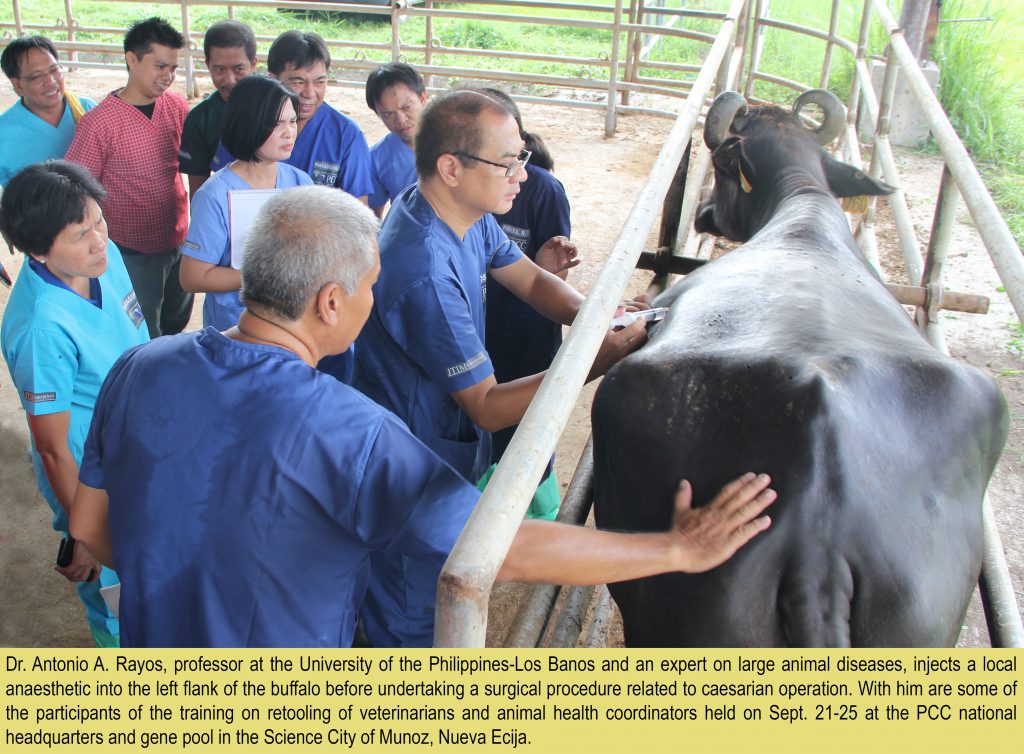Continuous training of veterinarians is one of the strategies to further develop their knowledge and skills in the early diagnosis of disease and proper management of sick animals.
This is one of the primary reasons behind the conduct of a training course on retooling of veterinarians and animal health coordinators of the Philippine Carabao Center (PCC) on September 21-25 held at the PCC National Headquarters and Gene Pool, Science City of Muñoz, Nueva Ecija.
The participants consisted of 20 veterinarians and animal health coordinators from the PCC regional centers and 13 staff from national headquarters.
Staff from PCC Animal Health and Biosafety Unit, NIZ and National Gene Pool served as facilitators and training support staff.
“This training is essential for us, especially for our veterinarians who directly handle animals in the Gene Pool, National Impact Zone (NIZ) and other PCC institutional herds. This could be of help to enhance the capability of our center veterinarians in dealing with emergency cases encountered in the field and to standardize the protocols we are teaching to our farmer-cooperators in addressing basic health issues,” Dr. Nancy C. Abes, PCC animal health coordinator, explained.
The five-day training was aimed at evaluating the current status of the water buffaloes among institutional herds, cooperatives and quarantine area of PCC; determining the animal health-related concerns or difficulties encountered by the PCC veterinarians in the farm or field; and assisting the animal health coordinators in the diagnosis of different diseases encountered in the field through review of important diseases affecting water buffaloes and re-introduction of the current animal health management.
Activities involved in the training were lectures on animal health program; presentation of herd health program and current animal health issues common to PCC herd per center; discussion of issues and concerns related to animal health; standardization of approved veterinary protocol and practices in the field; laboratory exercises; and surgical demonstration on prolapse repair, caesarian operation and rumenotomy.
Dr. Antonio A. Rayos, professor at the Dairy Products and Technology Development Division, Animal and Dairy Sciences Cluster, College of Agriculture at the University of the Philippines–Los Baños, provided a lecture and actual demonstration of the surgical procedure on caesarian operation and other related matters.
“Hangga’t maaari gusto natin na manganak ‘yong hayop ng normal lang pero kapag malaking masyado ang bulo at hindi niya mailabas, doon palang gagawin ang caesarian. Pagkatapos ng operation, pagkalipas ng dalawang linggo pwede ng tanggalin yung tinahi, ang post-operative procedures ay antibiotic sa loob ng mga pitong araw at sprayan ng disinfectant ‘yong sugat. (As much as possible we want the animals to give birth normally but if the calf is very big and it’s hard for her to take it out, that’s only the time to have a caesarian operation. Two weeks after the operation, we can now remove the skin suture. Some basic post-operative procedures include providing of antibiotic for about seven days and spraying of disinfectant to the wound),” Dr. Rayos explained.
After the training, the agency and participants are expected, among others, to have standardized animal health protocols as part of training modules for farmers and come up with best practices in animal health management that could be applied as integral part of the animal health program.

